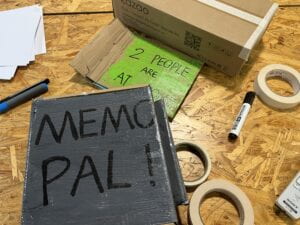The idea that our group focused on was an artifact from The Plague. The artifact that we came up with is an interactive message board that a person would put it in front of the door to their house. The message board changes depending on who interacts with the board. The main use of the message board is to relay custom messages to different people without additional communication. Different users have a keycard that they swipe the message board to see the message. For example, when the owner of the house leaves, they can leave a message to other family members on the message board about where they’re going and when they’ll come back. When another family member returns, they can see the message left by the owner. The message board can also display how many people are in the house. The color of the message would also signal something. For example, green means someone is at home, blue means someone is out and will be returning. Additionally, delivery drivers would also have a keycard, which allows them to see where the owner would want them to leave their packages.
During the research step. I defined interaction as “object/product/person is able to continuously change their reaction according to the actions of an external actor.” This artifact relates to the form of interaction that I identified in my research because the artifact’s reaction can be changed depending on who interacts it. Although the drawback of the artifact is that it is that the way it interacts with others depends on other users, the interaction is meaningful since it’s provided by someone else. Another failure of the artifact is that it doesn’t completely fit the world of The Plague. We assumed that the artifact had to be inspired by the story. However, the artifact could still fit in the world of The Plague since the artifact is thick because there is a battery connected to it if the electricity goes out. Also, keycards are used instead of Face ID because people are wearing the hazmat suits, which wouldn’t allow people to take off their suit.

While thinking about how to design this artifact, my contribution was to have to artifact be electronic and use to differentiate between users and maintain privacy. After coming up with the idea, we decided to think about how to create it using cardboard. We had a dilemma about whether we should have physical buttons for more interaction, but we decided against it at the end. However, other members in the group decided to include a flap to open the artifact to make it more interactive (but also makes it more unrealistic). We used a cardboard box as the template for the artifact, which was cut and painted. I wrote the messages that would be displayed by the artifact. After we finished the prototype of the artifact, we assigned roles to each other for the performance. We used different roles to show the different situations where the artifact could be used. The roles were delivery man, host, host’s mother, host’s friend, stranger, and box-holder. The script was that each person would have some type of interaction with the artifact, and the artifact would display different messages.
Analysis on Team Group’s Artifact & Performance
The group I’ll be talking about is Team Group. Their project was an artifact that is similar to VR (Virtual Reality) headset, but is much more technologically advanced. The artifact covers the eyes, and has wires that are connected to the gloves of the artifact. The artifact is able to simulate touch, smell, sounds, and vision. In their presentation, the artifact is used to cure a patient’s depression through a pleasant surreal experience on an island. I do like the design of the device, since it is based on VR. The addition of the wires connected to the headset is interesting design choice since current VR sets are wireless. The story that the artifact was inspired was from The Veldt. The artifact is relevant to the fictional story because it feels like something that would exist in that world. Similar to the scene changing room in the story, this artifact could become too addicting for the user even if its main functionality is for a helpful purpose. Their artifact does meet the criteria of the assignment since it is imaginative. Although, I believe it’s a bit too similar to VR. The performance was very good. The performance included every interactive aspect that the artifact can be used for. The use of props really helped to to understand the use of the artifact. My suggestion would be to implement additional equipment to the artifact. For example, head piece of the artifact could be more like a mask instead of just covering the eyes and ears.